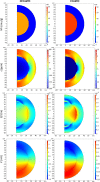Modeling of core-shell magneto-electric nanoparticles for biomedical applications: Effect of composition, dimension, and magnetic field features on magnetoelectric response
- PMID: 36149898
- PMCID: PMC9506614
- DOI: 10.1371/journal.pone.0274676
Modeling of core-shell magneto-electric nanoparticles for biomedical applications: Effect of composition, dimension, and magnetic field features on magnetoelectric response
Erratum in
-
Correction: Modeling of core-shell magneto-electric nanoparticles for biomedical applications: Effect of composition, dimension, and magnetic field features on magnetoelectric response.PLoS One. 2024 Nov 20;19(11):e0314414. doi: 10.1371/journal.pone.0314414. eCollection 2024. PLoS One. 2024. PMID: 39565784 Free PMC article.
Abstract
The recent development of core-shell nanoparticles which combine strain coupled magnetostrictive and piezoelectric phases, has attracted a lot of attention due to their ability to yield strong magnetoelectric effect even at room temperature, thus making them a promising tool to enable biomedical applications. To fully exploit their potentialities and to adapt their use to in vivo applications, this study analyzes, through a numerical approach, their magnetoelectric behavior, shortly quantified by the magnetoelectric coupling coefficient (αME), thus providing an important milestone for the characterization of the magnetoelectric effect at the nanoscale. In view of recent evidence showing that αME is strongly affected by both the applied magnetic field DC bias and AC frequency, this study implements a nonlinear model, based on magnetic hysteresis, to describe the responses of two different core-shell nanoparticles to various magnetic field excitation stimuli. The proposed model is also used to evaluate to which extent realistic variables such as core diameter and shell thickness affect the electric output. Results prove that αME of 80 nm cobalt ferrite-barium titanate (CFO-BTO) nanoparticles with a 60:40 ratio is equal to about 0.28 V/cm∙Oe corresponding to electric fields up to about 1000 V/cm when a strong DC bias is applied. However, the same electric output can be obtained even in absence of DC field with very low AC fields, by exploiting the hysteretic characteristics of the same composites. The analysis of core and shell dimension is as such to indicate that, to maximize αME, larger core diameter and thinner shell nanoparticles should be preferred. These results, taken together, suggest that it is possible to tune magnetoelectric nanoparticles electric responses by controlling their composition and their size, thus opening the opportunity to adapt their structure on the specific application to pursue.
Conflict of interest statement
The authors have declared that no competing interests exist.
Figures





Similar articles
-
Magnetoelectric nanoparticles shape modulates their electrical output.Front Bioeng Biotechnol. 2023 Aug 25;11:1219777. doi: 10.3389/fbioe.2023.1219777. eCollection 2023. Front Bioeng Biotechnol. 2023. PMID: 37691903 Free PMC article.
-
Field-controlled magnetoelectric core-shell CoFe2O4@BaTiO3 nanoparticles as effective drug carriers and drug release in vitro.Mater Sci Eng C Mater Biol Appl. 2021 Feb;119:111444. doi: 10.1016/j.msec.2020.111444. Epub 2020 Aug 26. Mater Sci Eng C Mater Biol Appl. 2021. PMID: 33321584
-
In silico assessment of electrophysiological neuronal recordings mediated by magnetoelectric nanoparticles.Sci Rep. 2022 May 19;12(1):8386. doi: 10.1038/s41598-022-12303-4. Sci Rep. 2022. PMID: 35589877 Free PMC article.
-
Recent advances, status, and opportunities of magneto-electric nanocarriers for biomedical applications.Mol Aspects Med. 2022 Feb;83:101046. doi: 10.1016/j.mam.2021.101046. Epub 2021 Nov 4. Mol Aspects Med. 2022. PMID: 34743901 Free PMC article. Review.
-
Magnetoelectric Magnetic Field Sensors: A Review.Sensors (Basel). 2021 Sep 17;21(18):6232. doi: 10.3390/s21186232. Sensors (Basel). 2021. PMID: 34577439 Free PMC article. Review.
Cited by
-
Temperature-Dependent Cytokine Neutralization Induced by Magnetoelectric Nanoparticles: An In Silico Study.Int J Mol Sci. 2024 Dec 19;25(24):13591. doi: 10.3390/ijms252413591. Int J Mol Sci. 2024. PMID: 39769353 Free PMC article.
-
Multiphysics simulation of magnetoelectric micro core-shells for wireless cellular stimulation therapy via magnetic temporal interference.PLoS One. 2024 Jan 25;19(1):e0297114. doi: 10.1371/journal.pone.0297114. eCollection 2024. PLoS One. 2024. PMID: 38271467 Free PMC article.
-
Foundational insights for theranostic applications of magnetoelectric nanoparticles.Nanoscale Horiz. 2025 Mar 24;10(4):699-718. doi: 10.1039/d4nh00560k. Nanoscale Horiz. 2025. PMID: 39898755 Free PMC article. Review.
-
Magnetoelectric nanoparticles shape modulates their electrical output.Front Bioeng Biotechnol. 2023 Aug 25;11:1219777. doi: 10.3389/fbioe.2023.1219777. eCollection 2023. Front Bioeng Biotechnol. 2023. PMID: 37691903 Free PMC article.
-
Correction: Modeling of core-shell magneto-electric nanoparticles for biomedical applications: Effect of composition, dimension, and magnetic field features on magnetoelectric response.PLoS One. 2024 Nov 20;19(11):e0314414. doi: 10.1371/journal.pone.0314414. eCollection 2024. PLoS One. 2024. PMID: 39565784 Free PMC article.
References
-
- Yang J, Xu Y. Principles and applications of the nano-in-nano integration for multidisciplinary nanofluidics. In: Multidisciplinary Microfluidic and Nanofluidic Lab-on-a-chip [Internet]. Elsevier; 2022. [cited 2022 Aug 23]. p. 407–28. Available from: https://linkinghub.elsevier.com/retrieve/pii/B9780444594327000121.
-
- Mekheimer KhS, Abo-Elkhair RE, Abdelsalam SI, Ali KK, Moawad AMA. Biomedical simulations of nanoparticles drug delivery to blood hemodynamics in diseased organs: Synovitis problem. Int Commun Heat Mass Transf. 2022. Jan;130:105756.
-
- Thumma T, Mishra SR, Abbas MA, Bhatti MM, Abdelsalam SI. Three-dimensional nanofluid stirring with non-uniform heat source/sink through an elongated sheet. Appl Math Comput. 2022. May;421:126927.
-
- Abdelsalam SI, Mekheimer KhS, Zaher AZ. Dynamism of a hybrid Casson nanofluid with laser radiation and chemical reaction through sinusoidal channels. Waves Random Complex Media. 2022. Apr 11;1–22.
MeSH terms
Substances
LinkOut - more resources
Full Text Sources

